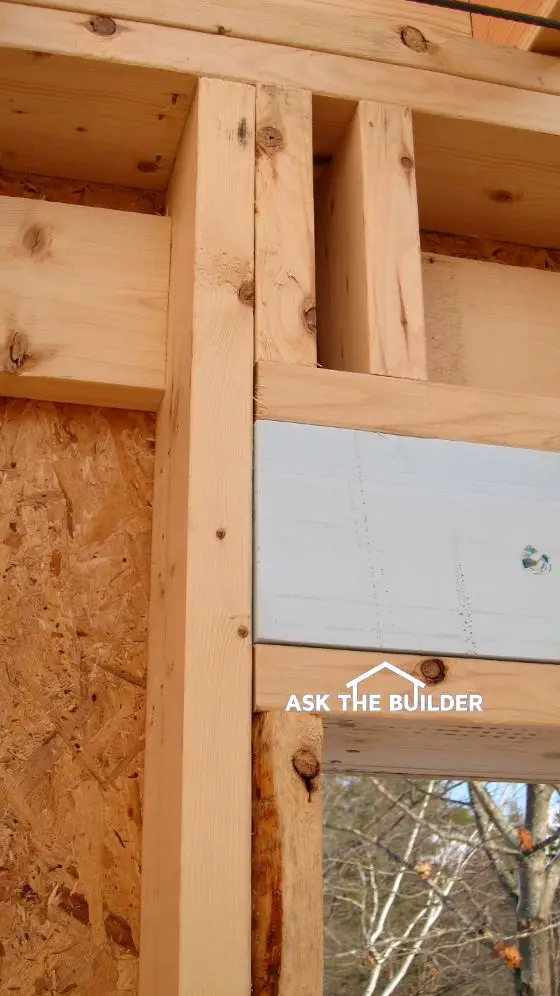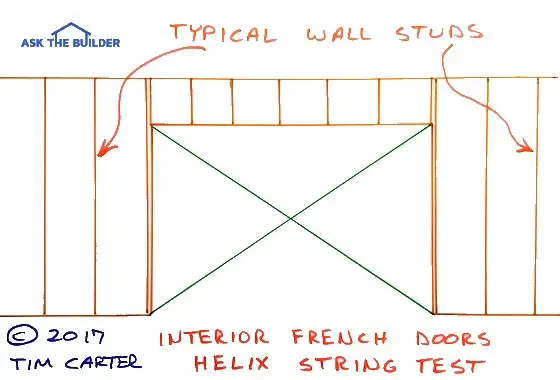Framing A Door

Framing a door in the USA and this is what it's going to look like. This is an exterior door showing the all-important beam covered with closed-cell foam. The load above the door is transferred to the framing on either side of the opening. Copyright 2018 Tim Carter
"A doorway in a non-load-bearing wall doesn't need a structural header. You'll place just one or two 2x pieces of lumber flat across the top of the opening."
I can call you on the phone to help you frame your door. The call is FREE if you're not satisfied with my tips and advice. I could save you hours of time and prevent WOOD ROT and mold caused by a lack of the correctly flashing! CLICK HERE to set up the call.
Framing a Door Tips
- a small beam is required in load-bearing walls
- king stud on either side must be straight
- perform string test with letter X
- use studs with vertical grain
DEAR TIM: I'm going to build a room addition myself because money is very tight. Can you help me understand how I frame in the door openings?
I've never done this before and am very confused. Is the method the same for all doors? How wide and tall do you make the opening?
What do I do on an exterior wall? Elizabeth S., Denver, CO
Related Links
How To Select Vertical Grain Studs Video
Interior Wall Framing Tips & Magic
DEAR ELIZABETH: I first want to congratulate you on your ambition and wisdom in asking questions before you get in trouble. No doubt it's easy to jump into a project, but in these very harsh economic times, you can't afford to waste any money on mistakes. Ask enough questions and you should be able to get through this daunting project.
Is it Hard to Frame a Door?
Framing a door is not too hard. There's absolutely a difference in how a door is framed for an exterior door versus an interior one.
Not all carpenters will do it the same way, so be prepared for different answers to your questions. There commonly is no one right answer.
How Do You Frame a Door in a Bearing Wall?
The first thing to understand is there could be a concentrated load above a door. This happens on bearing walls. In these instances, there's a structural header that acts as a beam over the door to support the load or weight that's bearing down on that portion of the house.
Where are Bearing Walls Located?
Bearing walls can be both on the exterior of the house as well as on interior walls. In the last house I built for my family, I had an interior bearing wall with a door in it. Immediately above the door was a concentrated load that I'd estimate was about four tons.
You can bet I installed a double 2x12 header above that door! Headers come in all sizes and usually, a structural engineer or an architect will size them for you.
Do You Need a Header in a Non-Bearing Wall?
A doorway in a non-load-bearing wall doesn't need a structural header. You'll place just one or two 2x pieces of lumber flat across the top of the opening.
This framing lumber is used to support the finished wall material and provide solid nailing for any trim around the door. It also acts as a tiny bottom plate for the cripple studs above the door opening that reach to the top plate.
How Straight Should the Framing Lumber Be?
When you frame a door, it's very important that you use the straightest pieces of framing lumber that you can find in the pile. What's more, you frame the door with a continuous bottom plate just as the wall has a continuous top plate.
The bottom plate at the doorway gets cut out after the wall is in place, secure and the bottom plate is securely fastened to the floor.
Do You Use a King Stud?
Door openings commonly have two king studs and two jack studs. A king stud is one that runs continuously from the top plate to the bottom plate. The jack stud is nailed to the king stud, but it's shorter as it supports the structural header or the flat 2x material that you use for a door in a non-load-bearing wall.
How Many Jack Studs Should Be In the Opening?
For rough openings 6 feet or less in width, one jack stud next to the king stud is normally what is required to support the structural header beam. Any opening over 6 feet should have two jack studs under each end of the beam.
Do You Need Cripple Studs Above the Door Opening?
You may have to install small cripple studs between the top of the header and the top plate when framing a door. These need to be a continuation of the other king studs on the wall being sure to maintain the even 16-inch or 24-inch on-center spacing you have for the finished wall material.
How Important is the Rough Opening for the Door?
The width and height of a rough opening for a door are very important. Your plans may call for a 3-foot-wide door that's 6-feet 8-inches tall. From years of experience, I'm here to tell you that the rough opening should be at least 38 and 1/4 inches wide and the height of the opening should be 84 inches.
Where Should the Bottom of the Exterior Door Threshold Be?
The bottom of the exterior door threshold should be at the same elevation as the top of the finished flooring material.
You must keep in mind that exterior doors have a threshold that's often at least 1-inch high and that the bottom of this threshold MUST be installed at the same elevation as the top of the finished floor in the house. Rookies often forget this making the rough opening too short.
What About the Height of Interior Doors?
Height considerations are the same for interior doors. These doors are set on the finished floor and there is almost always a 1-inch air gap under the door after it's installed.
How Do You Calculate the Exterior Door Rough Opening Height?
Here are the things you need to consider when adding up to get the rough opening height for an exterior door:
- the actual door height
- the thickness of the weatherstripping under the door
- the thickness of the threshold
- the thickness of the finished floor
- the thickness of the finished top door jamb
- add about one-half inch wiggle room for shims and other site conditions
How Do You Calculate the Rough Opening Width?
You do the same exercise to figure the rough opening for door width. You add the actual width of the door to the thicknesses of both finished jambs, plus add about 3/4 inch for shims and wiggle room.
What is the String Test for Rough Openings?
A string test for a rough opening is when you create the letter X using two strings stretched from opposite corners of the rough opening. If the two pieces of string barely touch one another, then the rough opening is in the same plane.

This is a crude drawing of a rough opening for interior french doors. The green lines are pieces of string attached to the corners of the rough opening. They must barely touch at the center of the "X". Copyright 2018 Tim Carter ALL RIGHTS RESERVED. Do NOT COPY
It's mandatory that the rough opening for a door be in the same plane. This is one function the top and bottom plates of a wall perform. If the plate material is straight, the bottom plate is installed perfectly straight and the wall is plumb, then the wall and opening will be in the same plane.
Should I Put a 4-Foot Level on the Studs to Check for Plumb?
NEVER plumb a wall putting a 4-foot level on the wall studs. If the stud the level is resting on has a crown or hump in it, the level will not give a true reading.
You plumb a wall using a perfectly straight piece of lumber that only contacts the top and bottom plate. Place this lumber between king stud locations so it's only touching the wall plates.
Column 913


18 Responses to Framing A Door